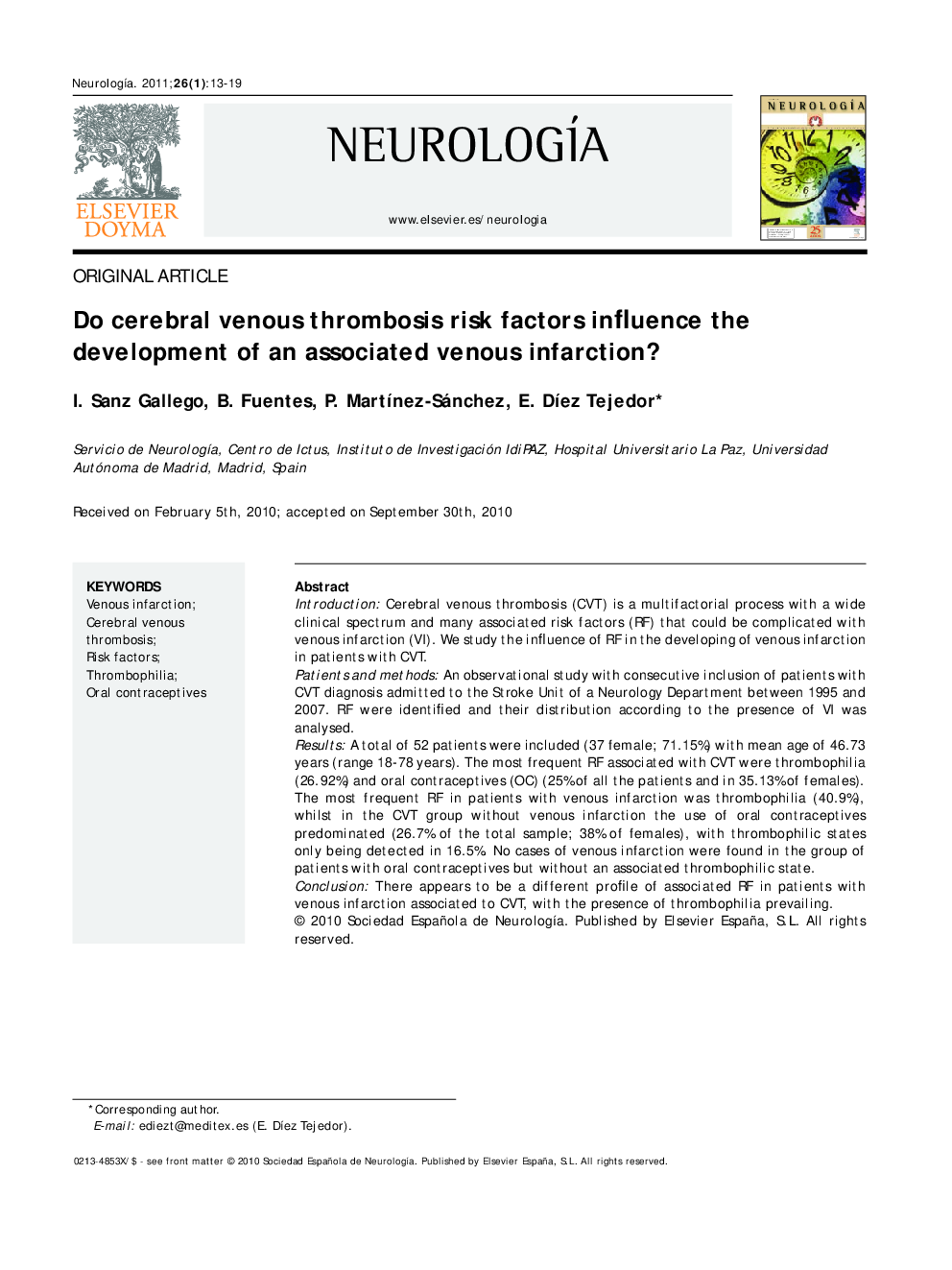| کد مقاله | کد نشریه | سال انتشار | مقاله انگلیسی | نسخه تمام متن |
|---|---|---|---|---|
| 3077664 | 1189160 | 2011 | 7 صفحه PDF | دانلود رایگان |

IntroductionCerebral venous thrombosis (CVT) is a multifactorial process with a wide clinical spectrum and many associated risk factors (RF) that could be complicated with venous infarction (VI). We study the infl uence of RF in the developing of venous infarction in patients with CVT.Patients and methodsAn observational study with consecutive inclusion of patients with CVT diagnosis admitted to the Stroke Unit of a Neurology Department between 1995 and 2007. RF were identifi ed and their distribution according to the presence of VI was analysed.ResultsA total of 52 patients were included (37 female; 71.15%) with mean age of 46.73 years (range 18–78 years). The most frequent RF associated with CVT were thrombophilia (26.92%) and oral contraceptives (OC) (25% of all the patients and in 35.13% of females). The most frequent RF in patients with venous infarction was thrombophilia (40.9%), whilst in the CVT group without venous infarction the use of oral contraceptives predominated (26.7% of the total sample; 38% of females), with thrombophilic states only being detected in 16.5%. No cases of venous infarction were found in the group of patients with oral contraceptives but without an associated thrombophilic state.ConclusionThere appears to be a different profi le of associated RF in patients with venous infarction associated to CVT, with the presence of thrombophilia prevailing.
ResumenIntroducciónLa trombosis venosa cerebral (TVC) es un proceso multifactorial con amplio espectro clínico y de factores de riesgo (FR), que puede presentar o no infarto venoso. Estudiamos los FR que infl uyen en el desarrollo del infarto venoso en pacientes con diagnóstico de TVC.Pacientes y métodosEstudio observacional con inclusión de pacientes consecutivos con diagnóstico de TVC atendidos por la Unidad de Ictus del servicio de Neurología entre los años 1995 y 2007. Se identifi can los FR y se analiza su distribución en función de la presencia del infarto venoso.ResultadosSe incluyeron 52 pacientes (37 mujeres; 71,15%) con edad media de 46,73 años (18-78 años). Los factores de riesgo de TVC más frecuentes fueron los estados de hipercoagulabilidad hereditarios (26,92%) y el uso de anticonceptivos orales (ACO) (25% del total muestral y 35,13% de las mujeres). Entre los FR identifi cados en pacientes con infarto venoso predominan los trastornos de hipercoagulabilidad hereditarios (40,9%) mientras que en los casos sin infarto venoso, el factor más frecuente es el uso de ACO (26,7%; 38% de las mujeres), estando presentes los estados de hipercoagulabilidad sólo en el 16,5%. No observamos ningún caso de infarto venoso con tratamiento ACO y sin estado de hipercoagulabilidad asociado.ConclusionesEn los pacientes con infarto venoso asociado a TVC parece existir un diferente perfi l de factores de riesgo asociado, predominando la presencia de estados protrombóticos hereditarios.
Journal: Neurología (English Edition) - Volume 26, Issue 1, 2011, Pages 13–19